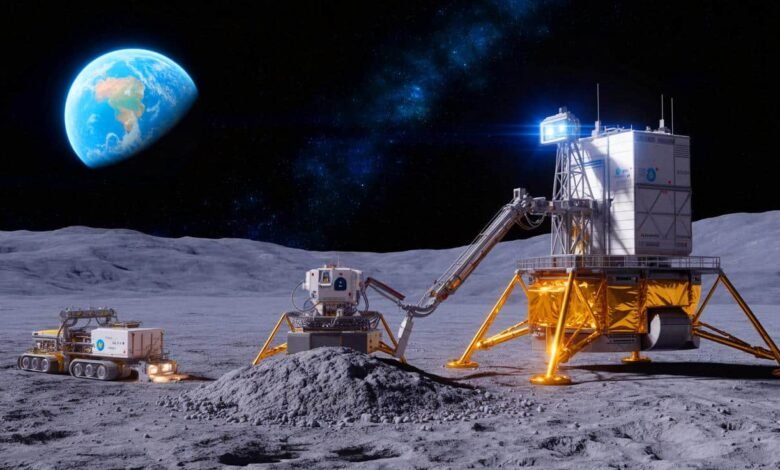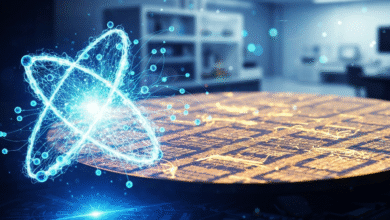Moon Helium-3 Mining Could Make Oil Obsolete

▼ Summary
– The Moon is a potential source for helium-3, a rare isotope crucial for quantum computing cooling and clean fusion energy.
– Helium-3 is vital for cooling quantum computers to near absolute zero and offers a clean fusion fuel with minimal radioactive waste.
– The United States and China are leading the race for lunar helium-3 mining, driven by strategic and technological interests.
– Extracting helium-3 from lunar soil presents significant engineering challenges, including processing vast amounts of regolith and operating in harsh lunar conditions.
– The geopolitical landscape could shift as nations compete for helium-3, with legal frameworks like the Artemis Accords shaping resource extraction rights.
The lunar surface, bombarded by solar winds for billions of years, holds a resource that could fundamentally reshape our technological and energy futures: the rare isotope helium-3. This material, scarce on Earth, is generating intense interest for its dual role in powering next-generation quantum computers and potentially fueling clean nuclear fusion reactors. The race to mine helium-3 has ignited a new space race, with global superpowers like the United States and China leading the charge to establish a foothold on this final frontier, driven by the profound strategic and economic advantages it promises.
Helium-3 is a rare commodity on our planet, primarily obtained in minuscule amounts from the decay of tritium within nuclear weapons stockpiles. These limited supplies are utterly inadequate for the burgeoning demands of the quantum computing industry. The Moon, however, presents a dramatically different picture. Scientists estimate its regolith, or surface soil, could contain millions of metric tons of this isotope, deposited over eons by the solar wind, creating a vast, untapped reservoir.
The importance of helium-3 extends far beyond its scarcity. In the world of quantum computing, it serves a critical function. Helium-3 is essential for cooling quantum bits, or qubits, to temperatures near absolute zero. This extreme cold is necessary to preserve the delicate quantum states that enable these machines to perform complex calculations far beyond the capability of traditional supercomputers. As quantum data centers begin to scale up, the demand for this super-coolant is projected to skyrocket.
Perhaps even more transformative is its potential as a fuel for nuclear fusion. Fusion reactions that use helium-3 produce significantly less long-lived radioactive waste compared to other fusion methods. This prospect of a nearly waste-free, powerful energy source has captured the imagination of scientists and policymakers, offering a vision of a future with abundant, sustainable power.
Turning this vision into reality, however, requires overcoming monumental engineering obstacles. Extracting helium-3 is not a simple process. The isotope is trapped within the lunar soil, necessitating the collection and processing of enormous volumes of regolith to obtain usable amounts. The proposed technique involves digging up the soil, heating it in special ovens to release trapped gases, and then meticulously separating the precious helium-3 from other volatiles.
The Moon itself is a hostile environment for industrial operations. Its fine, abrasive dust can quickly degrade machinery, while the vacuum of space and low gravity create a host of complications. Standard lubricants evaporate, and the multi-second communication delay with Earth makes direct, real-time control of equipment impossible. Success hinges on developing fully autonomous, highly robust mining harvesters and advanced purification systems that can operate for extended periods with minimal human intervention.
This pursuit has moved from the realm of science fiction into tangible planning. Governments and private corporations are now actively investing in the necessary technology. A significant milestone was the U.S. Department of Energy’s landmark purchase of lunar helium-3, signaling the material’s recognized strategic value. Private companies in the quantum and cryogenics sectors are also securing preliminary supply agreements, spurring further innovation and laying the practical groundwork for future mining endeavors. Reconnaissance missions are being planned to pinpoint areas with higher concentrations and to test extraction methods in situ.
This endeavor is as much a geopolitical contest as it is a technical one. Spacefaring nations are acutely aware that the first to secure a reliable supply of helium-3 could gain a decisive advantage in both quantum technology and clean energy. The legal landscape is complex. While the 1967 Outer Space Treaty forbids national claims of sovereignty over celestial bodies, it does not explicitly prohibit the commercial extraction of resources. The United States has proactively established legal precedents through domestic law and the international Artemis Accords, which outline principles for resource rights. Not all nations agree with this framework, setting the stage for potential disputes over the governance of off-world resources.
The implications are staggering. If one nation or corporation achieves dominance in the helium-3 supply chain, it could create a technological and economic paradigm shift, reminiscent of the current dynamics in the rare-earth elements market. The quest to mine the Moon for helium-3 represents a pivotal moment where cutting-edge innovation, national strategy, and global politics converge, with the potential to redefine power structures both on Earth and beyond.
(Source: Rude Baguette)





